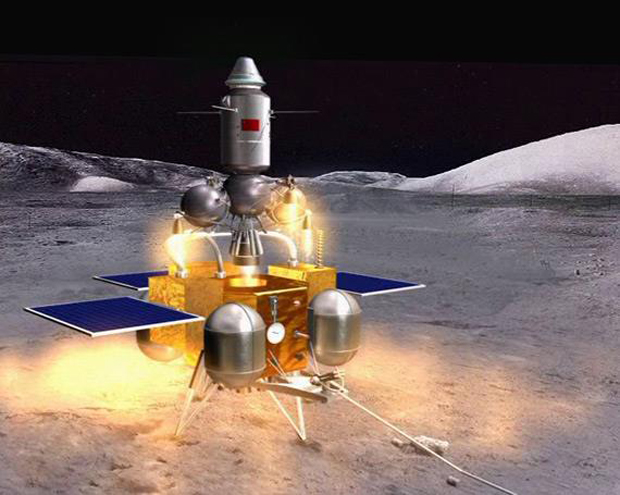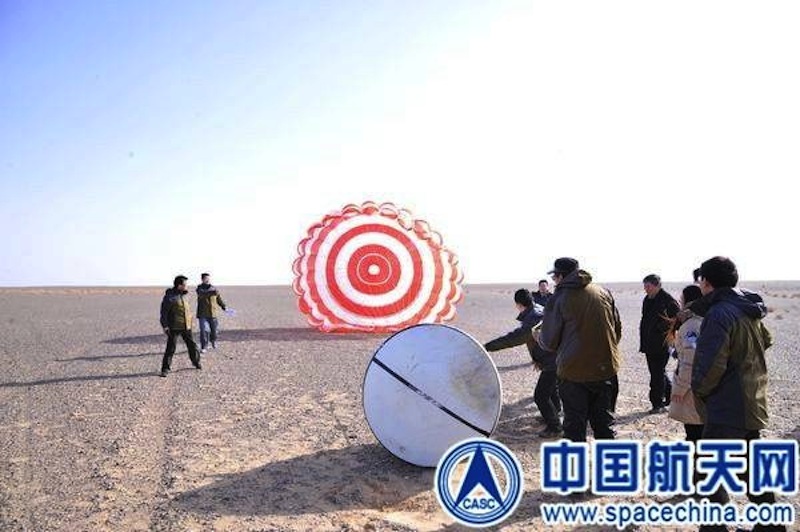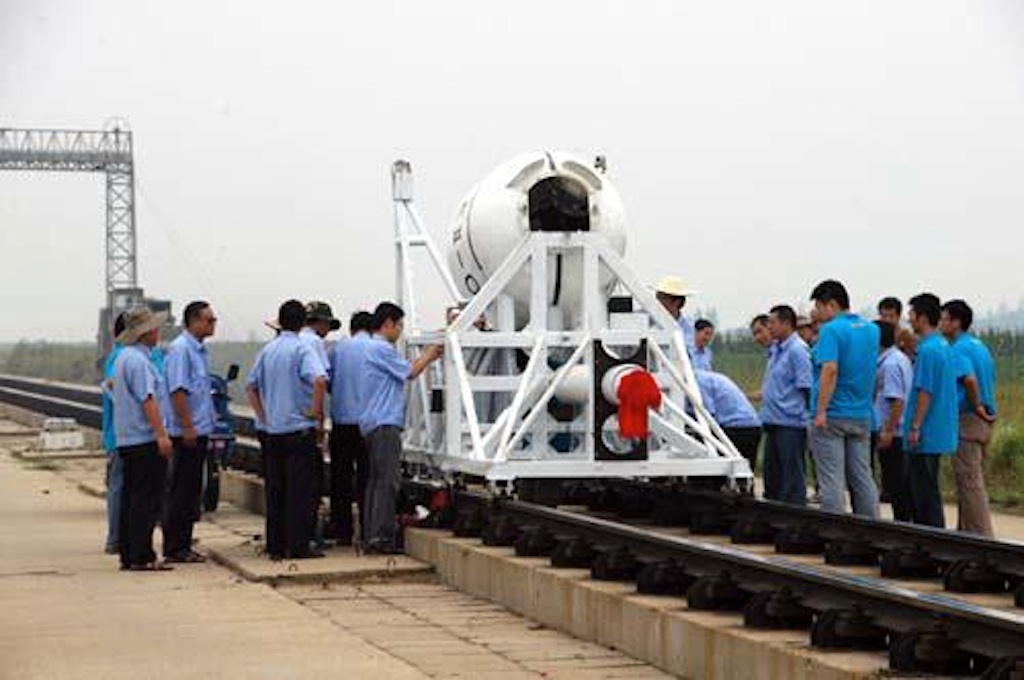
China Targets Moon Sample-Return Mission in 2017

As China's Chang'e 3 lander and Yutu rover mission to the moon unfolds, the country's space authorities are pushing forward on their next stage of lunar progress — gathering select samples of the moon and rocketing them back to Earth.
China plans to launch the unmanned sample-return mission, known as Chang'e 5, in 2017, signaling the third stage in the country's lunar exploration plans, officials said.
"The development of Chang'e 5 is proceeding smoothly," Wu Zhijian, a spokesman for China's State Administration of Science, Technology and Industry for National Defense, said in a Dec. 16 press conference. [See photos from China's Chang'e 3 moon rover mission]
Key technologies
As reported by China's state-run Xinhua news organization, Chang'e 4 is the backup probe for the Chang'e 3 mission, which successfully put a lander and rover down on the moon on Dec. 14. Chang'e 4 will be adapted to verify technologies for the sample-return initiative, which involves the Chang'e 5 and Chang'e 6 missions.
"The program's third phase will be more difficult because many breakthroughs must be made in key technologies, such as moon surface takeoff, sampling encapsulation, rendezvous and docking in lunar orbit, and high-speed Earth re-entry…which are all new to China," Wu said.
Wu also said that in the next stage of the lunar program, there will be more international cooperation.
Get the Space.com Newsletter
Breaking space news, the latest updates on rocket launches, skywatching events and more!
"Despite current progress, China still lags behind space giants like the United States and Russia in many aspects," Wu said. "We need to work harder and move faster."

Vital re-entry tests
The state-run newspaper China Daily reported earlier this year that an experimental spacecraft will be launched before 2015 to conduct vital re-entry tests on a capsule design to be used in the Chang'e 5 mission. That work is apparently now underway within a Gobi desert test site. Engineers are apparently also using a rocket sled as part of a Chang'e 5 re-entry test program.
The Chang'e 5 sample-return capsule would haul back the goods from the moon, plunging through Earth's atmosphere at a projected speed of about 25,000 mph (40,230 km/h). To date, no Chinese spacecraft has ever re-entered at that velocity, according to China Daily.
Citing Hu Hao, chief designer of the lunar exploration program's third phase, said that Chinese space scientists see an experimental spacecraft test as proving that Chang'e 5 can, indeed, bring lunar material safely back to Earth, China Daily reported. [Most Amazing Moon Missions of All Time]
Relay approach
Hu said that after Chang'e 5 enters lunar orbit, two modules would separate and land on the moon, with one collecting soil samples. Those specimens would be placed in an ascent module, which would blast off from the lunar surface and dock with the orbiting craft. The sample would then be transferred to the re-entry capsule for the trek back to Earth.
The Chang'e 5 mission involves a "relay" approach, one that requires precision rendezvous and docking in lunar orbit, Hu said.
Yan Jun, head of the National Astronomical Observatories of the Chinese Academy of Sciences and chief scientist of the lunar exploration program, said some lunar materials would be scooped up from the moon's surface, while other material would be acquired from a depth of about 6.6 feet (2 meters).

Scientific return
Sample-return sites must be picked with great care to maximize scientific return, said Paul Spudis, a planetary geology and remote sensing expert at the Lunar and Planetary Institute in Houston.

"Scientifically, sample-return has value only if you can relate the rocks you collect to some regional unit whose broad origins are known," Spudis told SPACE.com. Lunar samples must be collected, he said, such that their provenance and relation to a large-scale regional unit can be demonstrated.
Examples include samples of the youngest lava flows on the moon or the impact melt sheet of a fresh crater, like Copernicus, Spudis said.
"Samples collected from a unit of ambiguous context are much less valuable," Spudis said, "as you don't know exactly what the samples are telling you since you cannot put it into certain regional or global context."
Spudis listed a number of his favorite sites for a simple robotic sample-return mission, such as:
- Flamsteed P: Some of the youngest lava flows on the moon, possibly younger than 1 billion years.
- Copernicus floor: Impact melt rocks to date Copernicus impact and determine average crustal column at crater target site.
- Sinus Aestuum: Dark mantle deposits, regional pyroclastics, deep-origin and possible volatile resources (solar wind hydrogen).
Welcome news
China delivering new samples from the moon would be welcome news, said Carlton Allen, a planetary scientist and manager of the Astromaterials Acquisition and Curation Office at NASA's Johnson Space Center in Houston, Texas.
"I salute any nation's steps into space, including China's successful landing and roving on the moon," Allen said.
"A successful lunar landing is a testament to the skill of scientists, engineers, technicians and planners dedicated to an important and difficult goal," Allen told SPACE.com. "Bringing samples from the moon to Earth is an even more difficult undertaking, and the hallmark of a maturing space program."
Extraterrestrial samples are the "ground truth" of exploration, Allen said, solidifying scientific understanding of geologic history and its timescale.
"At this point, we have well-documented samples from six Apollo and three [Soviet Union] Luna landings, so additional samples from new locations are always welcome," Allen said. "If the samples are carefully collected on the lunar surface, if they are preserved and protected on Earth, and if they are studied by the best scientists in the best laboratories, these samples will open fresh insights into our moon and its environment."
Leonard David has been reporting on the space industry for more than five decades. He is former director of research for the National Commission on Space and is co-author of Buzz Aldrin's new book "Mission to Mars – My Vision for Space Exploration" published by National Geographic. Follow us @Spacedotcom, Facebook or Google+. Originally published on SPACE.com.
Join our Space Forums to keep talking space on the latest missions, night sky and more! And if you have a news tip, correction or comment, let us know at: community@space.com.

Leonard David is an award-winning space journalist who has been reporting on space activities for more than 50 years. Currently writing as Space.com's Space Insider Columnist among his other projects, Leonard has authored numerous books on space exploration, Mars missions and more, with his latest being "Moon Rush: The New Space Race" published in 2019 by National Geographic. He also wrote "Mars: Our Future on the Red Planet" released in 2016 by National Geographic. Leonard has served as a correspondent for SpaceNews, Scientific American and Aerospace America for the AIAA. He has received many awards, including the first Ordway Award for Sustained Excellence in Spaceflight History in 2015 at the AAS Wernher von Braun Memorial Symposium. You can find out Leonard's latest project at his website and on Twitter.









